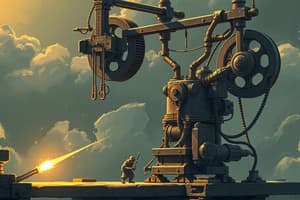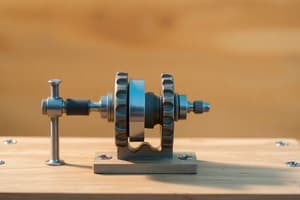Podcast
Questions and Answers
What is the main purpose of a machine as described in the text?
What is the main purpose of a machine as described in the text?
- To reduce speed gains
- To generate electricity efficiently
- To overcome large resistive forces by applying a small force (correct)
- To operate without any input force
What is an ideal machine according to the text?
What is an ideal machine according to the text?
- A machine with parts that are weightless and frictionless (correct)
- A machine with low efficiency
- A machine with energy dissipation
- A machine that is very heavy
Which statement best describes the efficiency of an ideal machine?
Which statement best describes the efficiency of an ideal machine?
- 100% efficiency with no energy loss (correct)
- 80% efficiency with energy loss
- 50% efficiency with some friction
- 20% efficiency with high energy consumption
How are machines useful in changing the point of application of effort?
How are machines useful in changing the point of application of effort?
Which type of lever is a pair of scissors considered as?
Which type of lever is a pair of scissors considered as?
In which situation would a jack be most commonly used?
In which situation would a jack be most commonly used?
How does a single fixed pulley change the direction of force when lifting a bucket from a well?
How does a single fixed pulley change the direction of force when lifting a bucket from a well?
Flashcards are hidden until you start studying
Study Notes
Ideal and Actual Machines
- An ideal machine has no loss of energy in any form, and work output equals work input.
- An actual machine always has some loss of energy.
Levers
- In a Class II lever, the effort is between the fulcrum and the load, so the effort arm is always smaller than the load arm, resulting in a Mechanical Advantage (M.A.) < 1.
- In a Class III lever, there is no gain in force, but there is a gain in speed, with a longer displacement of the load obtained by a smaller displacement of the effort.
Examples of Levers
- A bottle opener is a Class II lever, with the load in the middle, fulcrum at one end, and effort at the other.
- Sugar tongs are a Class III lever, with the effort in the middle, load at one end, and fulcrum at the other.
- The human arm is a Class III lever, with the elbow as the fulcrum, biceps exerting the effort, and the load on the palm.
- Raising the weight of the body on toes is an example of a Class II lever, with the fulcrum at the toes, load in the middle, and effort by muscles at the other end.
Pulleys
- A fixed pulley is a pulley with a fixed axis of rotation, used to change the direction of the force applied.
- The ideal mechanical advantage of a single fixed pulley is 1, with no gain in mechanical advantage.
- A single movable pulley has a mechanical advantage of 2 in the ideal case.
- The efficiency of a single movable pulley system is not 100% due to friction and the weight of the pulley and string.
Machines
- A machine is a device that allows us to overcome a large resistive force or obtain a gain in speed.
- An ideal machine has no dissipation of energy, with an efficiency of 100%.
- Machines are useful for lifting heavy loads, changing the point of application of effort, changing the direction of effort, and obtaining a gain in speed.
Studying That Suits You
Use AI to generate personalized quizzes and flashcards to suit your learning preferences.




